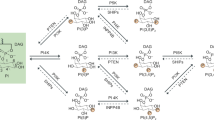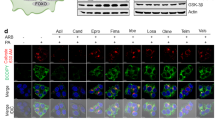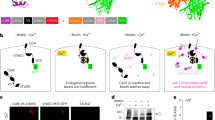Abstract
It is now established that a key step in the action of calcium-mobilizing agonists is stimulation of the hydrolysis of phosphatidylinositol 4,5-bisphosphate (PtdIns(4,5)P2) to 1,2-diacylglycerol and inositol 1,4,5-1 ris phosphate (InsP3)1,2. The latter substance acts as a second messenger, controlling the release of calcium from intracellular stores (see ref. 3 for review). The bifurcating nature of the signalling system is exemplified by the fact that the other product of PtdIns(4,5)P2 hydrolysis, 1,2-diacylglycerol, can alter cellular function by activating protein kinase C, the cellular target for several tumour-promoting agents such as the phorbol esters4,5. In various tissues, including GH3 pituitary tumour cells, a synergistic interaction between calcium ions and protein kinase C underlies agonist-induced changes in cell activity4,6–10. The data presented here suggest that when GH3 cells are stimulated by thyrotropin-releasing hormone (TRH), an agonist inducing PtdIns(4,5)P2 hydrolysis11–14, the two limbs of the inositol lipid signalling system interact to control free cytosolic calcium levels ([Ca2+]i). At low levels of TRH receptor occupancy, [Ca2+]i)increases rapidly, then declines relatively slowly. As receptor occupancy increases, the calcium signal becomes more short-lived due to the appearance of a second, inhibitory, component. This latter component, which is enhanced when [Ca2+]i) is elevated by high potassium depolarization, is mimicked by active phorbol esters and by bacterial phospholipase C. It seems likely that protein kinase C subserves a negative feedback role in agonist-induced calcium mobilization.
This is a preview of subscription content, access via your institution
Access options
Subscribe to this journal
Receive 51 print issues and online access
$199.00 per year
only $3.90 per issue
Buy this article
- Purchase on SpringerLink
- Instant access to full article PDF
Prices may be subject to local taxes which are calculated during checkout
Similar content being viewed by others
References
Downes, C. P. & Michell, R. H. Cell Calcium 3, 467–502 (1982).
Berridge, M. J. Biochem. J. 220, 345–360 (1984).
Berridge, M. J. & Irvine, R. F. Nature 312, 315–321 (1984).
Nishizuka, Y. Nature 308, 693–698 (1984).
Castagna, M. et al. J. biol: Chem. 257, 7847–7851 (1982).
Kaibuchi, K., Sano, K., Hoshijima, M., Takai, Y. & Nishizuka, Y. Cell Calcium 3, 323–335 (1983).
Zawalich, W., Brown, C. & Rasmussen, H. Biochem. biophys. Res. Commun. 117, 448–455 (1983).
Delbeke, D., Kojima, I., Dannies, P. S. & Rasmussen, H. Biochem. biophys. Res. Commun. 123, 735–741 (1984).
Martin, T. F. J. & Kowalchyk, J. A. Endocrinology 115, 1517–1526 (1984).
Martin, T. F. J. & Kowalchyk, J. A. Endocrinology 115, 1527–1536 (1984).
Rebecchi, M. J. & Gershengorn, M. C. Biochem. J. 216, 299–308 (1983).
Martin, T. F. J. J. biol. Chem. 258, 14816–14822 (1983).
Macphee, C. H. & Drummond, A. H. Molec. Pharmac. 25, 193–200 (1984).
Drummond, A. H., Bushfield, M. & Macphee, C. H. Molec. Pharmac. 25, 201–208 (1984).
Tsien, R. Y., Pozzan, T. & Rink, T. J. J. Cell Biol. 94, 325–334 (1982).
Gershengorn, M. C. & Thaw, C. Endocrinology 113, 1522–1524 (1983).
Albert, P. R. & Tashjian, A. H. J. biol. Chem. 259, 5827–5832 (1984).
Schlegel, W. & Wollheim, C. B. J. Cell Biol. 99, 83–87 (1984).
Kruskal, B. A., Keith, C. H. & Maxfield, F. R. J. Cell Biol. 99, 1167–1172 (1984).
Drummond, A. H., Knox, R. J. & Macphee, C. H. Biochem. Soc. Trans. 13, 58–60 (1985).
Gershengorn, M. C., Hoffstein, S. T., Rebecchi, M. J., Geras, E. & Rubin, B. G. J. clin. Invest. 67, 1769–1776 (1981).
Tan, K. & Tashjian, A. H. J. biol. Chem. 259, 427–434 (1984).
Niedel, J. E., Kuhn, L. J. & Vandenbark, G. R. Proc. natn. Acad. Sci. U.S.A. 80, 36–40 (1983).
Sando, J. J. & Young, M. K. Proc. natn. Acad. Sci. U.S.A. 80, 2642–2646 (1983).
Sharkey, N. A., Leach, K. L. & Blumberg, P. M. Proc. natn. Acad. Sci. U.S.A. 81, 607–610 (1984).
Blumberg, P. M. et al. Biochem. Pharmac. 33, 933–940 (1984).
White, J. R. et al. J. biol. Chem. 259, 8605–8611 (1984).
Garrison, J. C., Johnson, D. E. & Campanile, C. P. J. biol. Chem. 259, 3283–3292 (1984).
Kawahara, Y., Minabuchi, R., Sano, K. & Nishizuka, Y. Biochem. biophys. Res. Commun. 97, 309–317 (1980).
Rozengurt, E., Rodriguez-Pena, M. & Smith, K. A. Proc. natn. Acad. Sci. U.S.A. 80, 7244–7248 (1983).
Martin, T. F. J. in Prolactin: Basic & Clinical Correlates (Liviana, Padova, in the press).
Drust, D. S. & Martin, T. F. J. J. biol. Chem. 259, 14520–14530 (1984).
Gershengorn, M. C., Geras, E., Purrello, V. S. & Rebecchi, M. J. J. biol. Chem. 259, 10675–10681 (1984).
Sagi-Eisenberg, R., Lieman, H. & Pecht, I. Nature 313, 59–60 (1985).
Maclntyre, D. E., McNicol, A. & Drummond, A. H. FEBS Lett. 180, 160–164 (1985).
Drummond, A. H. & Raeburn, C. A. Biochem. J. 224, 129–136 (1984).
Limas, C. J. Biochem. Biophys. Res. Commun. 96, 1378–1383 (1980).
Lagast, H., Pozzan, T., Waldvogel, F. A. & Lew, P. D. J. clin. Invest. 73, 878–883 (1984).
Author information
Authors and Affiliations
Rights and permissions
About this article
Cite this article
Drummond, A. Bidirectional control of cytosolic free calcium by thyrotropin-releasing hormone in pituitary cells. Nature 315, 752–755 (1985). https://doi.org/10.1038/315752a0
Received:
Accepted:
Published:
Issue date:
DOI: https://doi.org/10.1038/315752a0
This article is cited by
-
cAMP- and diacylglycerol-mediated pathways elevate cytosolic free calcium concentration via dihydropyridine-sensitive, ?-conotoxin-insensitive calcium channels in normal rat anterior pituitary cells
Naunyn-Schmiedeberg's Archives of Pharmacology (2004)
-
The recombinant 5‐HT1A receptor: G protein coupling and signalling pathways
British Journal of Pharmacology (1999)
-
Effect of Thyrotropin-Releasing Hormone on Cerebral Blood Flow in Conscious Rat
Journal of Cerebral Blood Flow & Metabolism (1989)
-
Co-existence between receptors, carriers, and second messengers on astrocytes grown in primary cultures
Neurochemical Research (1989)
-
Calcium mobilizing hormones activate the plasma membrane Ca2+ pump of pancreatic acinar cells
The Journal of Membrane Biology (1988)



